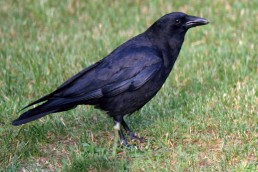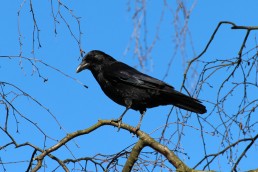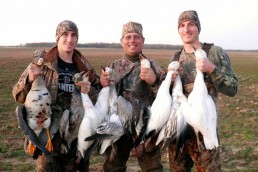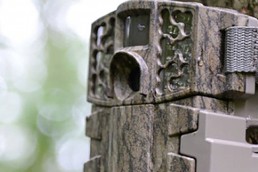Tackle Crafty Crows to Extend Your Hunting Season
SHARE THIS POST
Once the deer (gun and bow), duck, goose and pheasant seasons close, there are not that many seasons left if you still want to spend time outdoors hunting. A winged predator that is common in Wisconsin and the Midwest is the crow, or more exactly, the eastern crow. Crow hunting is becoming more and more popular. The hunting season has even been extended for those who want to try this challenging sport.
Crow hunting is rich in history and they have been hunted for hundreds of years. The early settlers soon learned that the Native Americans had a name for this ubiquitous black bird, and today it is one of the best-known birds in America. The crow’s large size, its glossy-black plumage and its raucous call make it readily identifiable. King Henry VIII put a bounty on crows, or as they were called “the despicable predator.” So, you can see that the crows have had a place in hunting history for a long time.
More than any other bird, the crow has been hunted and persecuted by man and still has managed to survive throughout its hereditary range, and has adapted itself to new environments and conditions. The crow’s survival is due to its resourcefulness and intelligence. Crows are one of the most intelligent bird species in North America.
To the amateur hunter, most of the crow calls sound the same or alike, and often in an attempt to imitate and lure in birds, he will inadvertently drive them off in terror by sounding an alarm call or a seductive love call. The wide emotional range includes notes of despair, cheer and chastisement. The most common call is the familiar “caw, caw,” which also has several modifications, including “gnaw, gnaw, orr, orr,” and “ah, ah.” The warning note of a crow doing sentinel duty over a feeding flock is a loud, prolonged “caw, c-a-a-w,” and it can be heard for a great distance.
The mature, adult crow is naturally wary and suspicious of everything strange and new, particularly those things that are near or associated with man, its chief enemy. This extreme caution is sharpened throughout the year, for the crow is regarded as a predator. The crow has few natural enemies because it roosts and nests in trees, and therefore is inaccessible to most animals. Its natural enemies include the larger hawks (red-tail and goshawks) and owls (horned and snowy). This relationship the crow has with hawks and owls is an example of predators preying on each other. Examples are when a group of crows attack an owl and eat its eggs—in turn, owls will snatch crows off their roosts
The diet of the crow is roughly 30 percent animal matter and 70 percent vegetable matter. These numbers vary accordingly to the availability of food on their range. Crows are known for the crop damage they can cause when they congregate in large numbers while migrating. They also can raise havoc when they invade waterfowl nesting areas and eat the nesting ducks’ eggs.
So, there are some things to learn before you go looking to hunt these birds. Shooting crows is more difficult than you would think. These birds are tricky, deceptive targets and are very unpredictable in their flight. Crows have keen eyesight that requires hunters to conceal themselves by wearing camo clothing. Moreover, crows are naturally suspicious of anything relating to man, so even a car parked on a country road can cause crows to detour their normal traveling routes.
I’ve found two ways of attracting birds when hunting: One of the methods is visual, requiring the use of a decoy, preferably an owl that is a traditional crow enemy, or crow-like decoys. The other method is vocal, where hunters use crow calls to “talk” like real crows, and lure the birds into shooting range. Owl and crow decoys should be used in areas where there are large concentrations of crows.
Are you enjoying this post?
You can be among the first to get the latest info on where to go, what to use and how to use it!
Crow calling is more popular because it is inexpensive and there is no cumbersome equipment to carry and set up. A still day with bright sunshine is best for calling since windy days limit the call’s range. One person can call and shoot crows successfully, but the best way is to have two callers act as partners.
Cruise the countryside looking for good spots to call. What makes up good crow country is another variable, but certain areas are generally more productive than others. The productive areas to seek are farmland, any woods near a garbage dump, the wooded outskirts of any town and any lake’s shore.
Many hunters use electronic callers, which are excellent and work extremely well. Electronic calls are illegal by all federal and state laws for use in hunting waterfowl, wild turkeys and other game birds. However, most states allow these calls for crow hunting
If there are crows in the area where you are calling, they will usually come quickly and head for the caller. Crows often become so excited with the prospect of a free meal that they forget some of their natural caution and fly boldly to the callers.
After they’ve been shot at, it’s difficult to get the birds to come to a call or decoy again. This is why it is important to have numerous spots where you can stop and hunt. There is not much reason to stay at a location too long because if there are crows around, you’ll soon know.
In my area of south-central Wisconsin, a setup with a blind and decoys will usually work. A group of five to 10 decoys is all that you need. Remove any dead crows from the field during your lull shooting periods. Most hunters find that crows are not that easy to hit. The birds appear to be flying faster than they really are, and over leading them often results. The kind of gun the hunter uses is an individual thing, but a 12-gauge gun is the most efficient killer. It handles the heaviest loads and does the best job. The No. 6 shot is the best all-around size, bar none. Choke size can vary too, but a full choke is the best for these wary birds that are often shot at longer distances.
You’ll find that crow hunting is fun, helps your shooting eye and allows you to get outside more toward the end of winter. In Wisconsin, the daily bag limit is 15 birds. The late-crow season opened January 26 and closes March 20. Be sure and have a valid small game license and bring plenty of shells. Do a Google search under “crow recipes” for some interesting ways to cook these wily birds.
MWO
SHARE THIS POST
Did you enjoy this post?
You can be among the first to get the latest info on where to go, what to use and how to use it!
Gary Engberg
If you have any questions or comments you may reach Gary Engberg at 608-795-4208 or garyengbergoutdoors.com.



